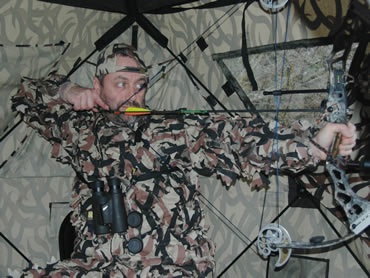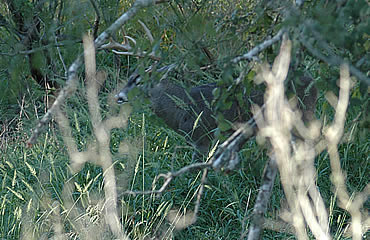How and where to place your stands for a variety of conditions.
What is a deer stand?
It can be as simple as a moss-covered stump overlooking an opening in the forest, or it can be a mechanical contraption engineered to elevate the hunter to whatever height he deems suitable. It might even be an enclosed room, outfitted with all the creature comforts.
Whichever you choose, there are some common characteristics about any setup that help it produce shots.
Manufactured stands come in a variety of shapes, sizes and configurations, and certain types are better suited to certain situations.
A climber might be a better option where you have to hike in on public ground or are trying out a new hotspot.
Lock-ons and ladders often are better for proven locations, and double-ladders allow a parent or mentor to partner with a youth or even a novice adult.
Ground blinds provide an option where no trees exist, and a stump, a stone wall or a flat rock might be all you need for a short sit between still-hunts.
Every situation is unique, but there are some generalities when it comes to where to place stands and what type to use, as well as when to hunt them. What follows are some general guidelines. Adapt and modify them to suit your circumstances or preferences.
 EARLY SEASON
EARLY SEASON
In early fall, the whitetail’s primary objective, when they’re not at rest, is food. Unless you’re hunting bedding cover, which is a low probability proposition, your best odds are to use stands associated with a food source, whether on the food or along a trail to a feeding area.
In agricultural areas, crops like corn and soybeans tend to be planted in a regular rotation. As long as the same type of crop is planted in a given field, deer usually follow the same trails, use the same fence crossings and enter and exit fields at roughly the same locations. This favors permanent stands like ladders and larger lock-ons or shooting houses, with the latter better suited to gun hunters. Much the same is true for food plots, which are the most regular of food sources if maintained annually.
One factor to consider when deciding where to place a stand is wind. You don’t want prevailing winds to blow directly into the plot or in the direction from which you expect deer to approach. Even enclosed blinds aren’t scent-proof, particularly on windy days.
Try to set up for quartering winds. With a northwest wind, for example, you might set up on the west side toward the south end of the plot. That way, you only give up the southeast quadrant. And you might want to place several stands so you have options for different wind directions.
Hunting the wind also applies to planning your approach. If you get winded walking in, you’ll see few, if any, deer. Prevailing wind is equally important to your stand site and your approach.
Things get a bit more complicated for bowhunters. Cover becomes a factor because bowhunting requires more movement. You’ll also be very close to the deer, so every aspect of stand position is important.
In the Midwest and West, deer will approach from whatever cover is available, which might be limited to one location or even a narrow corridor. That’s where to set up.
With food plots surrounded by woods, deer have more options. If you’ve hunted food plots, you’ve probably noticed deer tend to come out on the west side in the afternoon. There are a couple reasons for this. One is that prevailing winds are usually westerly — either southwest, northwest or due west. Approaching with the wind at their back, deer can see what’s in front and smell what’s behind.
Another reason is the west side gets the first shade. This is particularly important on warmer days. Deer want to be in the shade where it’s cooler and where their vision is more effective. Set up on the east side, and you could be in for a long afternoon, unless you’re a gun hunter.
Not all plots are created equal. Warm-season feeding plots are set up more for agricultural efficiency, are usually larger and most often are square or rectangular in shape. Smaller hunting plots, however, can be irregularly shaped, a fact bowhunters should use to their advantage. Set up on a point of timber that juts into a plot, or where the plot is most narrow.
For the most part, you’ll want to hunt on the plot edge early in the season. Bucks are still in bachelor groups and concerned mainly with feeding.
Later in the fall, things change, and so should you. More on that in a bit.
Natural foods can be more short-lived. White oaks tend to drop acorns early and over a brief time span. Red oaks might produce a bumper crop one year and none the next. Soft mast like apples and persimmons will be deer magnets, but only so long as ripe fruit is on the ground.
A climbing stand allows the hunter to be more adaptable, targeting food sources when and where they’re available. If you own or lease, you can erect permanent stands and only hunt them when they’re hot.
MORNING and AFTERNOON
Hunting food plots or crops in the morning can be tough because it’s almost impossible to get into a stand without bumping deer. You’re often better off hunting where you can intercept deer leaving the fields and heading back to bed. Save the food plots and crop fields for afternoon hunts. This also applies to natural food in the woods. Hunt closer to food in the afternoon and closer to bedding cover in the morning.
There are exceptions to every rule, and one is when hunting the big woods where concentrated food might be spotty.
Early in the fall, deer are still fairly predictable, feeding mostly at dawn and dusk. But as days grow colder, those activity periods expand. I’ve noticed there’s often a lull shortly after daylight, then a minor flurry of feeding activity around 8 or 9 in the morning before deer go off to bed for the day. That’s where morning hunts over food sources can be productive.
THE RUT
Things change as the rut kicks in. Bucks are on their feet more during daylight, and they’re no longer focused on food. That, more than ever, is when to concentrate on travel corridors.
In more open habitat, it’s relatively easy. Bucks will, for the most part, stick to thicker cover like fence rows, windrows and stream margins. In big woods, look for topographic features like steep ridges and saddles that funnel deer movement. And don’t forget the ’burbs. Suburban deer will use whatever narrow strips of cover exist among residences and other developed areas.
Don’t overlook feeding areas entirely, however. Does still come to food plots and concentrated food sources, and bucks will follow. There can still be plenty of deer on food plots, but that might not be the best place to set a stand, particularly if your objective is a mature buck.
Older bucks are much less inclined to place themselves at risk by venturing into the open during daylight. They’ve learned they can cruise the thick cover downwind of concentration areas to scent-check for hot does. It takes a lot of discipline to avoid quantity in favor of quality, but you could be better off setting up 50, 75 or even 100 yards downwind of a food plot or other food source.
 NEW AREAS
NEW AREAS
Hunting new areas is always a challenge because you know little or nothing about deer movement. It’s easier in agricultural areas, but you still don’t know where the deer are entering the fields. The first, obvious step is scouting for sign and looking for deer, and that becomes even more important when hunting in the woods.
But you don’t want to be too hasty. It’s tempting to set up right over a fresh scrape or other hot sign, but you’re probably better off playing it conservatively, particularly if you have the time.
Set up at a distance and watch to see which trails deer use most, or which ones bucks use, then adjust accordingly. Climbers and lock-ons with climbing sticks are ideal for this approach. Trail cameras can be very helpful because you can monitor deer activity without burning a hunting day.
GROUND BLINDS
Sometimes circumstances don’t allow for an elevated stand. Ground blinds should be placed well in advance of when you intend to hunt. Deer are wary of anything new or different. They will get used to a seemingly out of place structure in time, but you don’t want to waste valuable hunting time waiting for that to happen. Also, incorporate as much natural cover as possible to help your blind blend in with the surroundings.
LATE SEASON
Late season is much like early season in that the deer will once again be focused on food. One major difference is that food and cover are much more scarce. Deer will use the cover and food that remain, and that’s where you should concentrate your efforts. Bucks, depleted by the rut, tend to drop their guard a bit, so you can move back out to the edges of fields and food plots. In the woods, look for spots where hard mast exists, and bring in a climber or set a lock-on.
Another difference with late season is temperature. It’s much harder to sit for long periods in the cold and wind, so enclosed towers and ground blinds are more desirable. You can even add a portable heater, or just keep the windows closed if your blind has them.
FINALLY
While these tips are generalities, they should give you a good starting point in deciding where and when to hunt, and what type of stand to use.
Personal preference is a strong consideration. Some folks prefer climbers, while others like the permanence of a lock-on or the added space and comfort of a ladder. Still others might like the security and comfort of a large box blind, while those uncomfortable with heights might opt for a ground blind.
Some stands work better in certain conditions, but setting up according to the wind and a whitetail’s needs at a given time are more important than stand type every time.
Read Recent Articles:
• All in a Day’s Work: Awesome buck gives new meaning to the Eastern Shore’s scenic nickname.
• The Perfect Morning: Illinois bowhunter waits for just the right day to hunt his favorite stand.
• They Call it Buck Fever: It’s one thing to see this malady on TV. It’s quite another to feel it first-hand.
This article was published in the September 2012 edition of Buckmasters Whitetail Magazine. Subscribe today to have Buckmasters delivered to your home.